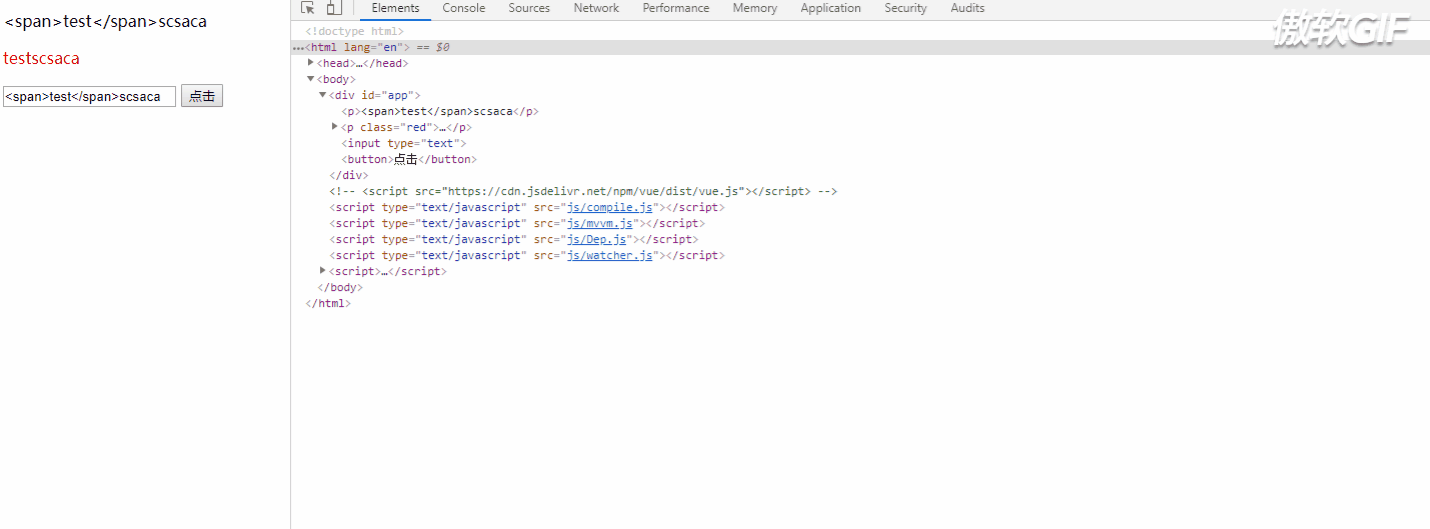自制简单的mvvm框架
实现原理
- 用Object.defineProperty()实现数据代理,添加getter和setter方法。这样当数据发生改变时,setter方法就会执行
- 用fragment()对模板进行拷贝,保存到内存中。
- 用node.nodeType得到fragment在节点类型,再对模板中节点上指令进行解析,为节点添加对应的方法和数据,再把fragment放到页面上。
实现步骤
1. 实现mvvm
- 创建vm对象对data对象进数据代理
1.1 对传递来的data参数进行保存
1.2 对data中的key进行代理,这样实现vm.key来访问data中的数据
1.3 调用observe方法对保存在vm中的data中的所有数据进行数据代理,添加描述和getter和setter方法
2.getter方法被调用dep对象,对vm中的依赖进行管理,setter方法被调用时会调用Dep中的notify方法从而调用watcher中的update方法. - 数据代理完成后调用compile对模板进行编译(必须在在数据代理完成后进行)
class mvvm{
constructor(options) {
// 将选项对象保存到vm
this.$options = options;
// 将data对象保存到vm和data变量中
this._data = this.$options.data
// 实现data对象的数据代理
this.observe(this._data);
// 执行编译
this.$compile = new Compile(options.el, this);
}
observe(value) {
if (!this.isObject(value)) {
return;
}
// 遍历value中所有的属性
Object.keys(value).forEach(key => {
// 为vue的data做属性代理
this.proxyData(key);
// 对指定属性实现响应式数据绑定
this.defineReactive(value, key, value[key])
});
}
proxyData(key) {
Object.defineProperty(this, key, {
configurable: false, // 不能再重新定义
enumerable: true, // 可以枚举
get() {
// 当通过vm.属性名 读取属性值时自动调用
return this._data[key];
},
set(newVal) {
// 将最新的值保存到data中对应的属性上(实现代理写操作)
this._data[key] = newVal;
},
});
}
defineReactive(obj, key, val) {
// 创建与当前属性相对应的Dep对象
let dep = new Dep();
// 递归查找嵌套属性
this.observe(val);
let this_ = this;
// 为data对象定义属性
Object.defineProperty(obj, key, {
configurable: false,
enumerable: true,
get() {
// 建立dep与watcher的关系
if (Dep.target) {
dep.depend();
}
console.log(dep.deps)
return val;
},
set(newVal) {
if (newVal === val) {
return;
}
val = newVal;
// 新的值是object的话,进行监听
this_.observe(newVal);
// 通知watcher属性发生改变
dep.notify()
}
})
}
isObject(obj) {
return obj !== null && typeof obj === 'object'
}
}2. 实现comlile
- 获取页面中节点的
- 将节点中的子节点拷贝到fragment中
- 利用nodetype对fragment中的不同类型节点进行分门别类的解析操作,解析后调用更新方法进行数据替换或方法绑定
3.1 文本节点进行解析: 如果有{{ }}那么直接用textContent替换为对应数据
3.2 元素节点则对指令进行解析:
+v-html:利用innerHTML方法替换数据
+v-model:先为value赋值,再用addEventListener绑定方法,如果人为改变调用对应方法,
+@click:从vm中得到方法的内容,通过addEventListener绑定方法并重新绑定方法中this的指向。
3.3 对text,html,model等在替换数据或赋值后,要为当前使用的data数据添加一个Watcher订阅者方法,建立watcher和compile之间的桥梁,保存当前数据的key和回调方法(回调方法会调用节点更新的方法)。
// 扫描模板中所有依赖创建更新函数和watcher
class Compile {
constructor(el, vm) {
this.$vm = vm;
this.$el = document.querySelector(el);
if (this.$el) {
// 将dom节点转换为Frament提高执行效率
this.$fragment = this.node2Fragment(this.$el);
// 编译fragment中所有层次子节点
this.init()
// 将生成的结果追加到el中
this.$el.appendChild(this.$fragment)
}
}
node2Fragment(el) {
// 创建一个新的Fragment
let fragment = document.createDocumentFragment();
let child;
// 将原生节点拷贝至fragment
while ((child = el.firstChild)) {
fragment.appendChild(child);
}
return fragment;
}
init() {
// 编译fragment
this.compileElement(this.$fragment)
}
compileElement(el) {
let childNode = el.childNodes;
Array.from(childNode).forEach(node => {
if (this.isElementNode(node)) {
// 元素节点要识别指令属性
this.compile(node)
} else if (this.isTextNode(node) && /\{\{(.*)\}\}/.test(node.textContent)) {
// 文本节点,只关心{{xx}}格式
this.compileText(node, RegExp.$1) // RegExp.$1 匹配上面正则分组的内容
}
// 遍历可能存在的子节点
if (node.childNodes && node.childNodes.length) {
// 递归调用实现所有层次节点的编译
this.compileElement(node);
}
})
}
compile(node) {
// 获取所有标签属性节点
const nodeAttrs = node.attributes;
// 遍历所有属性
Array.from(nodeAttrs).forEach(attr => {
// attr: v-on:click="onclick" 或 @click="onClick", v-text="test"
// 属性名: v-on:click, v-text,@click
const attrName = attr.name
// 判断是否是指令属性
if (this.isDirective(attrName)) {
// 得到表达式(属性值): test,onClick,
let exp = attr.value;
// 判断是否是事件指令
if (this.isEventDirective(attrName)) {
// 解析事件指令
let dir = attrName.indexOf("@") >= 0 ? attrName.substr(1) : attrName.substr(5);
this.eventHandler(node, this.$vm, exp, dir)
} else {
let dir = attrName.substr(2);
// 解析普通指令
this[dir] && this[dir](node, this.$vm, exp)
}
// 移除指令属性
node.removeAttribute(attrName);
}
})
}
compileText(node, exp) {
this.text(node, this.$vm, exp.replace(/^\s+|\s+$/g, ''));
}
isElementNode(node) {
return node.nodeType == 1; // 元素节点
}
isTextNode(node) {
return node.nodeType == 3; // 文本节点
}
// 判断是否是指令
isDirective(attr) {
return /^v-|^@|^:/.test(attr);
}
// 判断是否是事件指令
isEventDirective(dir) {
return /^@|^v-on:/.test(dir);
}
// 解析v-text/{{}}
text(node, vm, exp) {
this.update(node, vm, exp, 'text')
}
// 解析v-html
html(node, vm, exp) {
this.update(node, vm, exp, 'html')
}
// 解析v-class
class(node, vm, exp) {
this.update(node, vm, exp, 'class')
}
// 解析v-mode
model(node, vm, exp) {
this.update(node, vm, exp, 'model')
let val = this.getVMVal(vm, exp)
node.addEventListener('input', e => {
let newValue = e.target.value;
if (val === newValue) {
return;
}
this.setVmVal(vm, exp, newValue);
val = newValue;
})
}
// 得到表达式对应的value
getVMVal(vm, exp) {
let val = vm._data;
exp = exp.split('.');
exp.forEach(k => {
val = val[k];
});
return val;
}
setVmVal(vm, exp, value) {
let val = vm._data;
exp = exp.split('.');
exp.forEach((k, i) => {
if (i < exp.length - 1) {
val = val[k];
} else {
val[k] = value
}
})
}
// 事件处理
eventHandler(node, vm, exp, dir) {
let fn = vm.$options.methods && vm.$options.methods[exp];
if (dir && fn) {
// 1.绑定指定事件名和回调函数的DOM事件监听
// 2.将回调函数中的this强制绑定为vm
node.addEventListener(dir, fn.bind(vm), false)
}
}
// 更新节点方法
update(node, vm, exp, dir) {
let updaterFn = this[dir + "Updater"];
// 执行节点更新
updaterFn && updaterFn(node, this.getVMVal(vm, exp));
// 创建表达式对应的watcher对象
new Watcher(vm, exp, (val, oldVal) => {
// 当对应的属性值发生了变化时, 自动调用, 更新对应的节点
updaterFn && updaterFn(node, val, oldVal);
})
}
textUpdater(node, value) {
node.textContent = typeof value == 'undefined' ? '' : value;
}
htmlUpdater(node, value) {
node.innerHTML = typeof value == 'undefined' ? '' : value;
}
modelUpdater(node, value) {
node.value = typeof value == 'undefined' ? '' : value;
}
classUpdater(node, value, oldValue) {
let className = node.className;
className = className.replace(oldValue, '').replace(/\s$/, '');
let space = className && String(value) ? ' ' : '';
node.className = className + space + value;
}
}3. 实现watcher
Watcher订阅者作为observe和compile之间通信的桥梁。
- comlile中添加的订阅者时会,触发数据代理的getter方法从而在dep中添加一个watcher订阅者,建立起watcher和observe的桥梁。
- 在数据代理的setter方法调用,会触发所有在dep依赖管理器中储存的watcher的updata方法,然后调用延迟get方法触发获取最新数据,触发回调,调用更新节点的方法从容而更新页面是的数据。
// Watcher: 订阅者:具体的更新执行者
class Watcher {
constructor(vm, exp, callack) {
this.vm = vm;
this.exp = exp;
this.cb = callack;
this.depIds = {};
this.value = this.get();
}
update() {
// 得到最新的值
let value = this.get();
// 得到旧值
let oldVal = this.value;
// 如果不相同
if (value !== oldVal) {
this.value = value;
// 调用回调函数更新对应的界面
this.cb.call(this.vm, value, oldVal);
}
}
addDep(dep) {
if (!this.depIds.hasOwnProperty(dep.id)) {
// 建立dep到wacther的关系
dep.addDep(this)
// 建立wacther到dep的关系
this.depIds[dep.id] = dep;
}
}
get() {
Dep.target = this;
// 获取当前表达式的值, 内部会导致属性的get()调用
let value = this.getVMVal();
Dep.target = null;
return value;
}
getVMVal() {
let exp = this.exp.split('.');
let val = this.vm._data;
exp.forEach(key => {
val = val[key]
})
return val;
}
}4. 实现dep
Dep依赖管理器:负责将vm中的所有依赖收集管理,包括依赖添加和通知
var uid = 0;
// 依赖管理器:负责将vm中的所有依赖收集管理,包括依赖添加和通知
class Dep {
constructor() {
this.id = uid++;
this.deps = []; // 存放相关的所有watcher数组
}
addDep(dep) {
this.deps.push(dep)
}
depend() {
Dep.target.addDep(this);
}
notify() {
// 通知所有相关的watcher执行更新
this.deps.forEach(dep => {
dep.update();
})
}
}测试:
<div id="app">
<p>{{ msg }}</p>
<p v-html="msg" v-class="red"></p>
<input type="text" v-model="msg">
<button @click="click">点击</button>
</div>
<!-- <script src="https://cdn.jsdelivr.net/npm/vue/dist/vue.js"></script> -->
<script type="text/javascript" src="js/compile.js"></script>
<script type="text/javascript" src="js/mvvm.js"></script>
<script type="text/javascript" src="js/Dep.js"></script>
<script type="text/javascript" src="js/watcher.js"></script>
<script>
var vm = new mvvm({
el: '#app',
data: {
msg: '<span>test</span>',
red:'red'
},
methods: {
click() {
alert('点击')
}
}
})
</script>